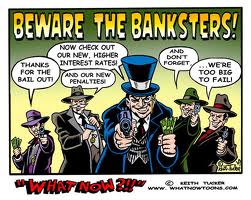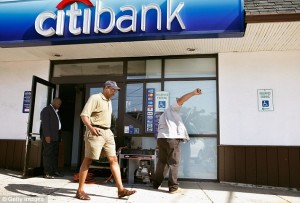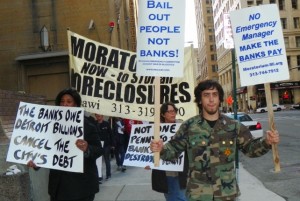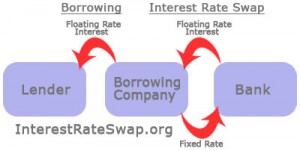(VOD editor: Detroit must take a cue from Baltimore and other cities who are taking a stand against the banks.)
“Baltimore has been leading a battle in Manhattan federal court against the banks that determine the interest rate, the London interbank offered rate, or Libor, which serves as a benchmark for global borrowing and stands at the center of the latest banking scandal. Now cities, states and municipal agencies nationwide, including Massachusetts, Nassau County on Long Island, and California’s public pension system, are looking at whether they suffered similar losses and are weighing legal action. Dozens of lawsuits filed by municipalities, pension funds and hedge funds have been consolidated into a few related cases against more than a dozen banks that are involved in setting Libor each day, including Bank of America, JPMorgan Chase, Deutsche Bank and Barclays.” (New York Times)
The Huffington Post | By Mark Gongloff
July 11, 2012
The news on Wednesday that cities and states are suing some of the world’s largest banks over Libor manipulation shows how this scandal could blow up into one of history’s biggest bank frauds.
That’s because interest-rate manipulation might well have kept your town or state from hiring firefighters or teachers, from paving roads or paying for indigent care or after-school programs for your kids — adding to the human suffering of the economic collapse these same banks caused in the first place.
If it’s any consolation, the lawsuits and fines over this manipulation could potentially cost the banks — which include not only Barclays but Bank of America, JPMorgan Chase, Citigroup, and many more — billions of dollars.
“This could get very ugly in a hurry for some banks,” Peter Tchir of TF Market Advisors wrote in a note.
And this could finally be enough to make Americans stop reacting to the Libor scandal with “a shrug,” as Joe Nocera recently put it, and push them closer to believing what Robert Shapiro, founder of economic advisory firm Sonecon, calls possibly “the biggest financial fraud in history.”
Would it be enough, maybe, to finally cause banks to lose the argument that regulating them too much will hurt the economy?
The New York Times wrote Wednesday that several states, towns and other municipalities are rounding up posses of lawyers to sue big banks over their manipulation of Libor, a short-term interest rate that affects borrowing costs throughout the global economy. Barclays has admitted to manipulating the rate for years, paying $450 million in penalties. Other banks are under investigation for doing the same thing. The scandal has already engulfed Treasury Secretary Tim Geithnerand Federal Reserve Chairman Ben Bernanke who have been asked to testify before a Senate subcommittee about rate manipulation.
The states and cities suing the banks often bought — from some of the same banks they’re suing — credit derivatives called interest-rate swaps. The swaps protected them when Libor rose, but hurt them when Libor fell. If these states and cities can prove the banks manipulated Libor lower, then they could have a case that the banks owe them some money.
Other potential litigants — hedge funds, maybe — bought derivatives that cost them money when Libor rose. Again, if they can prove that banks manipulated Libor higher, then they, too, could have a case that banks owe them money.
How much money are we talking?
 Some of Wall Street’s best thinkers have scoffed that such lawsuits will likely result in small potatoes, or maybe tater tots at best. It could be hard to suss out how much financial damage somebody really suffered from this, or how much any one bank — or even more than one bank — is responsible.
Some of Wall Street’s best thinkers have scoffed that such lawsuits will likely result in small potatoes, or maybe tater tots at best. It could be hard to suss out how much financial damage somebody really suffered from this, or how much any one bank — or even more than one bank — is responsible.
And a lot of borrowers, maybe including the same states and cities suing the banks, arguably benefitedwhen the banks manipulated Libor lower, because it lowered their borrowing costs.
But the sheer vastness of the derivatives market makes this a potentially huge headache for the banks. There’s a general estimate floating around that Libor affects about $800 trillion in notional derivatives — that’s “trillion,” not “billion” or “million.” Banks are not going to be on the hook for anything near that much, as the bulk of this amount is “notional” — meaning, roughly, “not real.”
What is far more likely is that people with derivatives contracts tied to Libor lost tiny percentages of that $800 trillion with some regularity because of Libor manipulation. Some municipalities in the Times story estimate Libor manipulation cost them millions of dollars — $13 million in the case of Nassau County, New York, for example. That’s the same Nassau County whose crushing long-term unemployment is the subject of an HBO documentary, “Hard Times: Lost On Long Island.”
That’s “millions,” not “trillions.” Tater tots, if you’re a bank. But priceless for a municipality struggling to hire workers, build infrastructure or take care of the people being crushed by the recession and painfully slow recovery.
And there are hundreds, maybe thousands, of municipalities involved in this. A 2010 Wall Street Journal article about how states and cities were losing money on derivatives noted that in Pennsylvania alone, 107 school districts owned interest-rate derivatives during the time period banks were allegedly manipulating rates.
That’s 107 school districts in one state alone losing untold millions of dollars because of lower interest rates, which may have been lower than they should have been because of Libor manipulation. That’s 107 school districts in one state alone that had a harder time paying teachers, buying computers, of funding art programs.
Peter Tchir of TF Market Advisors tried in a research note this morning to arrive at what some of the big numbers might look like, if all of these potential litigants decided to up and hit the banks all at once.
If the banks were responsible for moving the three-month Libor rate by just 1/100th of a percentage point on that entire universe of $800 trillion in notional derivatives contracts, then that would be worth $20 billion, according to Tchir’s calculations.
Banks are probably not going to be on the hook for derivatives worth anything close to that $800 trillion. But if banks manipulated rates by more than that 1/100th of a point, or for more than 90 days — the term of three-month Libor — on even smaller notional derivative amounts, then the numbers can still get big in a hurry. And that doesn’t even include punitive damages. And it doesn’t include the estimated $10 trillion in mortgages and other loans tied to Libor, including $275 billion worth of U.S. mortgages, according to an estimate from the Office of the Comptroller of the Currency referenced in the FT.
“That is the real exposure a bank caught ‘lying’ faces,” Tchir writes. “If the lie was big enough and for a long enough period and anyone entitled to receive payment based on LIBOR can make the claim, the potential damage to the bank is enormous.”
For more info, click on:
- http://articles.baltimoresun.com/2012-07-14/business/bs-bz-libor-suit-20120714_1_baltimore-suit-banking-watchdog-libor
- http://www.washingtonpost.com/business/economy/baltimore-takes-lead-in-suit-against-banks-over-alleged-libor-manipulation/2012/07/11/gJQAN3V7dW_story.html?wprss=rss_business










